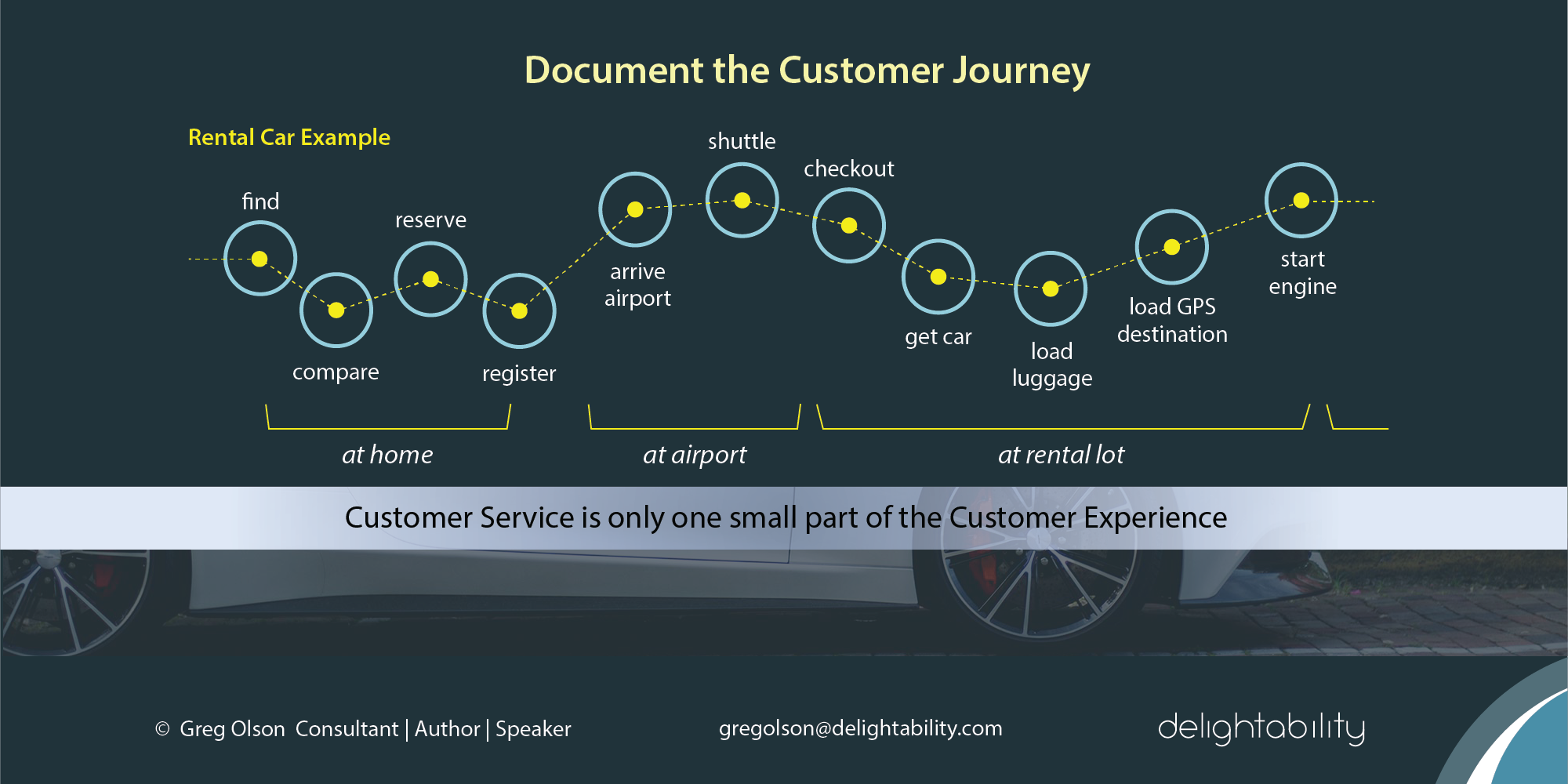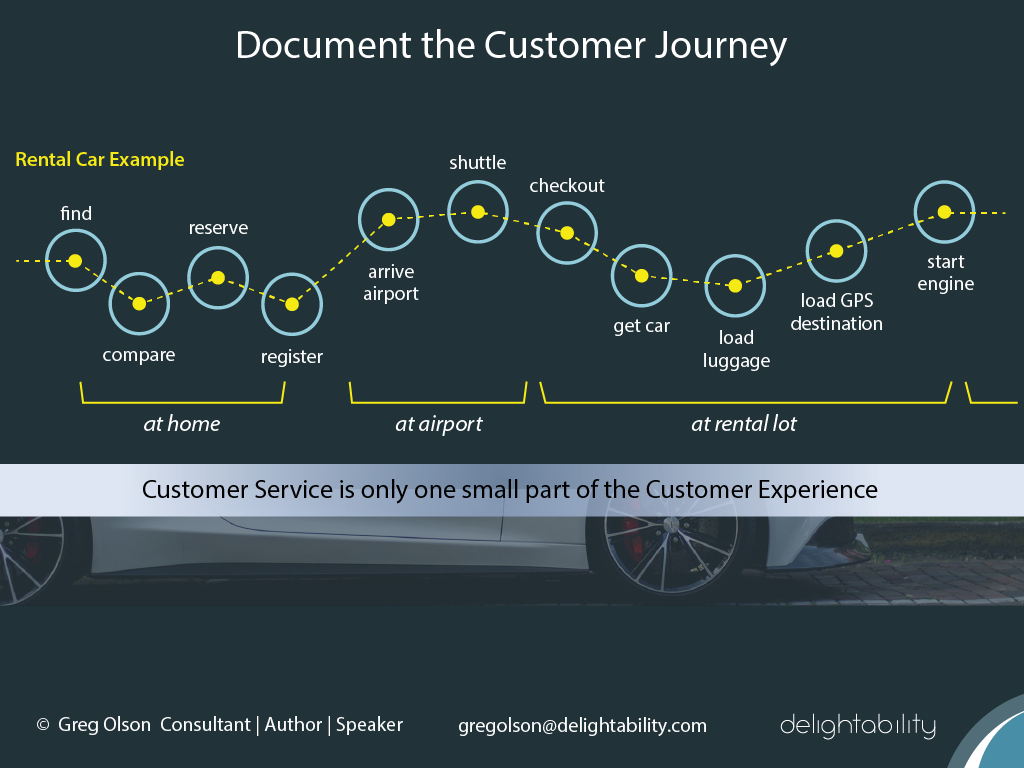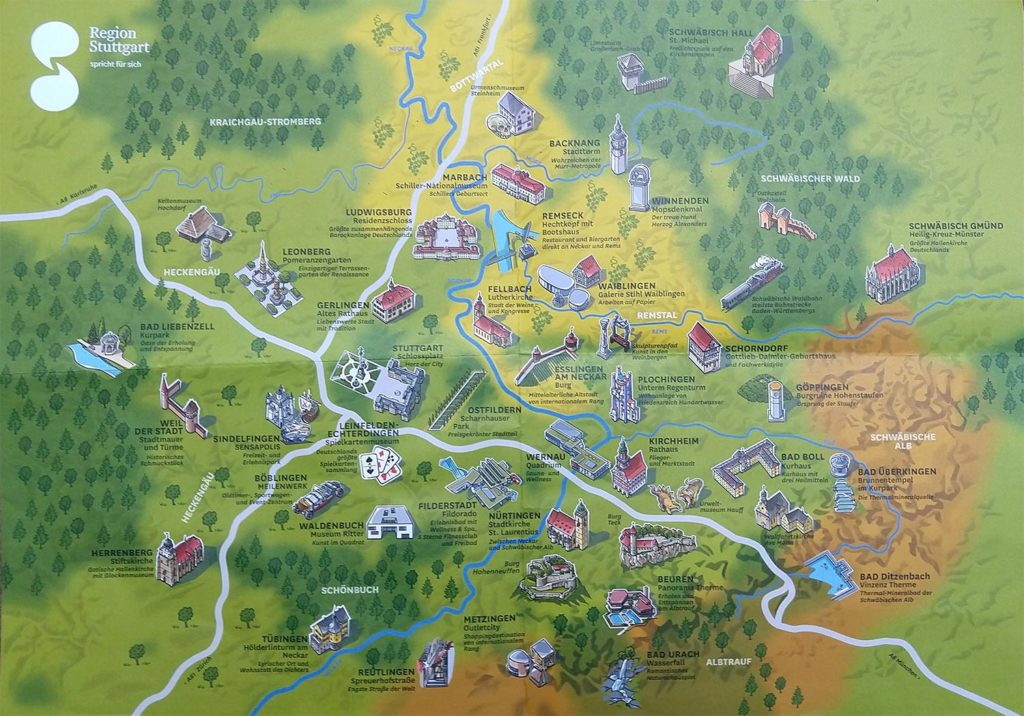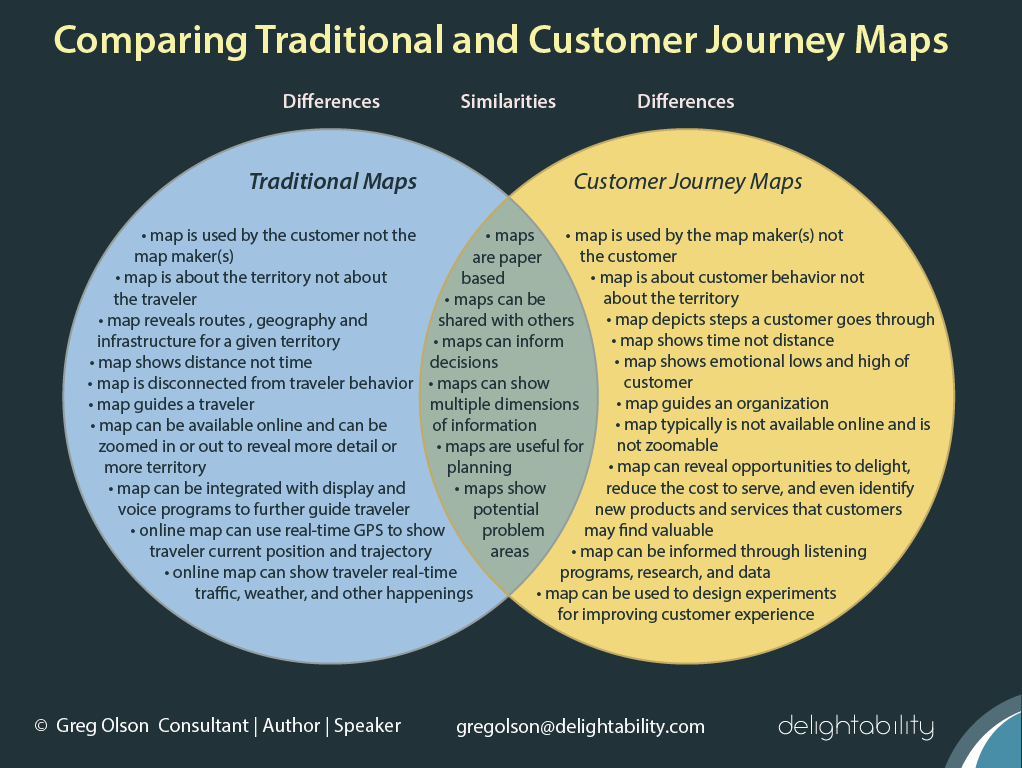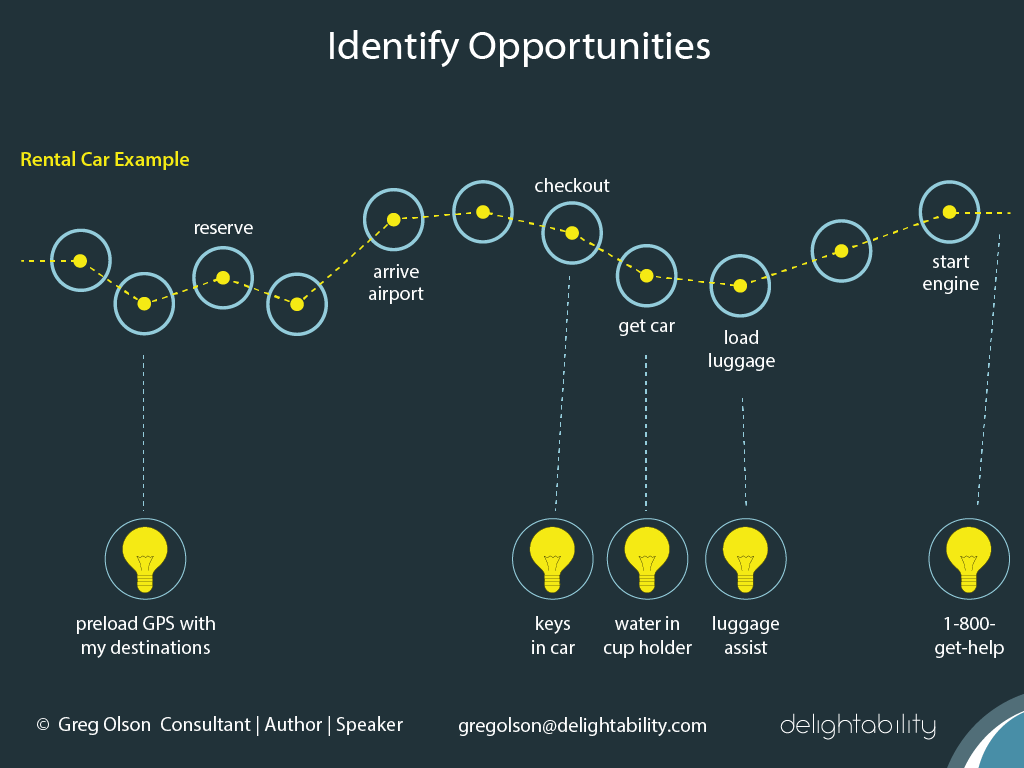Home » Freebies » Map Journeys
This article especially pertains to chapters 1, 4, 5, 6, and 7 in Gregory Olson's book, The Experience Design Blueprint, a book about designing better experiences and then making them come true.
- Chapter 1: What Makes an Experience?
- Chapter 4: Modeling the Customers Journey
- Chapter 5: The Rental Car Journey
- Chapter 6: Aiming for Remarkable, Unbroken, and Generous Design
- Chapter 7: Improving the Journey
Preview The Experience Design Blueprint
In the first section of "The Experience Design BLUEPRINT" I help readers to build their vocabulary and confidence in improving existing experiences as well as intentionally designing fresh ones. You can preview the book online.
Getting Grounded in Relevant Terminology
- Experience
- Touchpoint
- Customer
- Customer Journey
- Customer Journey Map
What is an Experience?
In The Experience Design Blueprint, I define an experience as a contextual interaction between people, objects, services, and spaces. Who's the who matters and so does their context. I introduce two mental models, the Experience Hoop and the Experience Halo to help readers fully grasp this seemingly simple, yet deeply complex topic. Chock that complexity up to the human brain and psychology. Organizations that ignore the psychological aspect of experiences (Experience Halo) do so at their own peril.
What is a Touchpoint?
From Chapter 4 of The Experience Design Blueprint, "A touchpoint is where a customer has an interaction with an organization or a brand. Think of the organization touching the customer, and vice versa, through a variety of means. It is easy to recognize a touchpoint when there is a visible and physical interaction like speaking to an employee at a bank or grocery store. But, a touchpoint needn’t be face to face or physical. Touchpoints can also be digital like visiting a website or receiving an email. Touchpoints are interacted through the senses by seeing, smelling, hearing, tasting, and touching."
What is a Customer?
The term, customer, is strewn about on this website, in my book, and most everywhere out of convenience. Recognize that customer may also mean other audiences including: member, donor, investor, visitor, prisoner, voter, citizen, tenant, resident, student, guest, traveler, passenger, performer, elected official, inspector, owner, parishioner, supplier, vendor, consultant, partner, board member, adviser, council member, leader, refugee, patron, staff, volunteer, client, shareholder, agency, patient, child, doctor, administrator, buyer, licensee, immigrant, refugee, soldier, driver, guide, occupant, person experiencing homelessness, employee, taxpayer. And, that is not an exhaustive list.
What is a Customer Journey?
The customer journey is a collection of experiences at touchpoints over time. Journey types vary along with the duration of the journey. Journeys can be about a relationship that changes over time, or they can be about a shorter duration transaction or event.
What is a Customer Journey Map?
Customer journey maps show touchpoints and the emotional lows and highs that a typical customer or a persona has at each of those touchpoints (See Experience Halo in Chapter 1). The type of journey being explored and the duration varies according to the needs of the map making team. For example, a financial services firm might wish to explore a long term relationship journey whereas a sport team might be more interested in the journey the customer experiences from purchasing tickets to in-stadium behavior and post game social sharing (advocacy). A concessionaire within that stadium might only be interested in the customer's transactional journey from initial queuing, purchase, gathering condiments, and exiting.
In my book and in the images on this page I use a rental car journey as an example because most of us have rented a car, so we can all relate.
You're Practically a Customer Experience Expert
No matter where you sit in the organization and what your title or tenure is, you have an attribute that qualifies you to map customer journeys. The fact is YOU are a customer. You are also likely a member, donor, investor, sponsor, citizen, activist, patient, patron, volunteer, contributor, parent, grandparent, son or daughter, landlord, guest, and many other things from the customer list above. You didn't know you were such a versatile actor, did you? You are also familiar with maps; that further qualifies you!.
How is a Customer Journey Map Different from a Traditional Traveler Map?
Traditional maps for travelers reveal routes and show geography and infrastructure for a given territory. The aim of the mapmaker is to guide the traveler toward a destination. Once a traditional map is created and published the mapmaker doesn't encounter the travelers who will use the map. Travelers might get to their destination or might not; the mapmaker will never know. The mapmaker is disconnected from the travelers experience.
I've shown an image of a map that I used while visiting Stuttgart, Germany. Though I'm not a native German speaker I was able to use the map to stay oriented, find my intended destinations which included the Porsche Museum (a well designed experience), and get back to my hotel. Because I was not familiar with the territory and the map doesn't include train stations, all destinations, or distances, I often relied upon the kindness of strangers who would help me find my location on the map, point me in the right direction, or estimate how far away something was. The map was useful to me as a traveler for navigation and for communicating to others.
Those remarks about the traditional traveler map generally apply whether the traveler is driving, biking, walking, or cycling. Now, let's contrast a traditional map with a customer journey map. Customer journey maps have some of the same characteristics as traditional maps such as: both maps can be produced on paper and shared with others. And, both maps enable better planning.
But, there are major differences between traditional maps and journey maps. Online versions of traditional maps can be zoomed in and out revealing more detail or more territory. Most customer journey maps are paper based and don't have this ability. Also, customer journey maps are used by the mapmaker not by the customer. In fact, the customer journey map is about the customer, and less so about the territory.
A Venn Diagram Comparison
For more similarities and difference see the Venn diagram of the traditional map and a customer journey map.
Reasons to Map Customer Journeys
I offer the contrast between traditional maps and customer journey maps to indoctrinate you into the world of customer journey mapping. No matter if you do this on your own, work with a facilitator (like me), and a cross-functional team (hopefully) there are serious benefits awaiting your organization. The insights you gain through customer journey mapping and the subsequent conversations they spark can provide you with tremendous advantage over competitors. Mapping can reveal opportunities to delight, reduce the cost to serve, and even empower your team to identify new products and services that customers could find valuable.
Benefits Organization and Customers
- Improves organizational effectiveness by eliminating blindspots, work arounds, and leaky funnels (see Explore Issues)
- Reduces the cost to serve
- Increases relevance with customers by improving communications, i.e., channels, messaging content, and timing
- Differentiates products and services from competitors
- Delights customers (identify more "water bottle" moments)
- Identifies new products and services that customers may find valuable
- Validates existing products and services or identifies pivots as needed
- Increases customer understanding and employee empathy
- Identifies trends and changes in the business landscape and customer ecosystem to future proof the business and stay relevant with customers (See Promise Delivery System)
- Creates a framework by which to run experiments and test campaigns, product concepts, and messaging
The Rental Car Journey Map Example
The touchpoints in the rental car journey map example probably look familiar to you. After all, most likely you have rented a car before. The relevance of each touchpoint or its emotional level depends largely on the audience. Remember, who's the who matters and so does their context. A business traveler or vacationing family or elderly widow traveling alone all have a very different context.
Using Journey Maps to Identify Innovation Opportunities
From Chapter 7: Improving the Journey, "By applying a filter, we can reduce the touchpoints in rental car journey down to what is relevant for a specific audience. For the business traveler with preferences on file with the rental car company’s loyalty program, the touchpoints “compare cars” and “queue at checkout” might not be relevant. The business traveler might have the ability to bypass the line and the car preference is already stored. Likewise, pivoting on the elderly widow audience might reveal a heightened interest in “load luggage” and “catch shuttle” with a decreased emphasis on “load GPS.” Filtering on an audience or persona can help you to focus on what is important for that audience by more closely walking in their shoes. This creates an opportunity to differentiate products and services from competitors, improve messaging to audiences, and spawn innovative products and services as shown."
High Performing Organizations Have Better Conversations
You can see, experiences are a little more complex than what initially meets the eye. A better conversation centers around your team pivoting on customers and imagining the steps, touchpoints, they go through no matter the duration and type of their journey. By applying filters, lenses, and levers to customer journey maps, your cross functional team of marketing managers, sales managers, product managers, executives, customer services, partners, etc., can systematically uncover opportunities that might otherwise lay dormant or be "randomly" yet intuitively proposed outside of any real framework to actualize the opportunities. Above all, customer journey maps are a communication tool that gets your team on the same page, having a better conversation about the customers you serve today and those you will thoughtfully and deservedly serve in the future.
Discuss Projects
Ready to discuss your needs?


